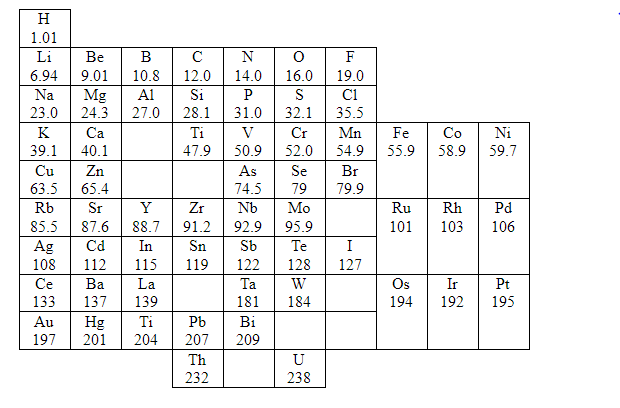
According to Mendeleev's periodic law, the properties of elements are a periodic function of:
(A) Atomic number
(B) Atomic weight
(C) Number of electrons
(D) Density
Answer
147.3k+ views
Hint: The Modern periodic table considers atomic number as the fundamental property that decides the properties of elements while Mendeleev’s version considers some other property. This property of the Modern periodic table corrected all the defects of Mendeleev’s periodic table.
Step-by-Step Solution:
Let us begin by studying Mendeleev’s periodic law and its resultant classification of elements in detail. Here, Symbols of elements and its atomic masses are shown

In 1869, a Russian chemist, Dmitri Mendeleev published a periodic table, which was after five years when John Newlands discovered his partly successful Law of Octaves. Mendeleev also arranged the elements that were known at the time in order of their relative atomic mass, but he did some other things that made his table much more successful.
Mendeleev considered atomic masses as fundamental property in order to classify elements. Based on atomic mass Mendeleev compared elements based on their atomic masses. He also studied their physical and chemical properties. While studying chemical properties he primarily considered the compounds formed by elements with oxygen and hydrogen as these elements form compounds with most of the elements.
After his study he started arranging the elements based on increasing atomic masses. With the physical and chemical properties, he found that every eighth element has properties similar to first. So, he placed every eighth element below the first. Likewise, he arranged all 63 elements in rows and columns.
Therefore, the answer to this question is (B) Atomic Weight.
Note: Be very careful between the basis of classification between the Modern and Mendeleev periodic laws, because the former uses atomic number as its basis for classification while the later uses atomic weight.
Step-by-Step Solution:
Let us begin by studying Mendeleev’s periodic law and its resultant classification of elements in detail. Here, Symbols of elements and its atomic masses are shown

In 1869, a Russian chemist, Dmitri Mendeleev published a periodic table, which was after five years when John Newlands discovered his partly successful Law of Octaves. Mendeleev also arranged the elements that were known at the time in order of their relative atomic mass, but he did some other things that made his table much more successful.
Mendeleev considered atomic masses as fundamental property in order to classify elements. Based on atomic mass Mendeleev compared elements based on their atomic masses. He also studied their physical and chemical properties. While studying chemical properties he primarily considered the compounds formed by elements with oxygen and hydrogen as these elements form compounds with most of the elements.
After his study he started arranging the elements based on increasing atomic masses. With the physical and chemical properties, he found that every eighth element has properties similar to first. So, he placed every eighth element below the first. Likewise, he arranged all 63 elements in rows and columns.
Therefore, the answer to this question is (B) Atomic Weight.
Note: Be very careful between the basis of classification between the Modern and Mendeleev periodic laws, because the former uses atomic number as its basis for classification while the later uses atomic weight.
Recently Updated Pages
How to find Oxidation Number - Important Concepts for JEE

How Electromagnetic Waves are Formed - Important Concepts for JEE

Electrical Resistance - Important Concepts and Tips for JEE

Average Atomic Mass - Important Concepts and Tips for JEE

Chemical Equation - Important Concepts and Tips for JEE

Concept of CP and CV of Gas - Important Concepts and Tips for JEE

Trending doubts
JEE Main 2025 Session 2: Application Form (Out), Exam Dates (Released), Eligibility, & More

JEE Main Exam Marking Scheme: Detailed Breakdown of Marks and Negative Marking

JEE Main 2025: Derivation of Equation of Trajectory in Physics

Electric Field Due to Uniformly Charged Ring for JEE Main 2025 - Formula and Derivation

JEE Main Participating Colleges 2024 - A Complete List of Top Colleges

Degree of Dissociation and Its Formula With Solved Example for JEE

Other Pages
JEE Advanced Marks vs Ranks 2025: Understanding Category-wise Qualifying Marks and Previous Year Cut-offs

JEE Advanced 2025: Dates, Registration, Syllabus, Eligibility Criteria and More

JEE Advanced Weightage 2025 Chapter-Wise for Physics, Maths and Chemistry

Hydrocarbons Class 11 Notes: CBSE Chemistry Chapter 9

NCERT Solutions for Class 11 Chemistry In Hindi Chapter 1 Some Basic Concepts of Chemistry

Learn About Angle Of Deviation In Prism: JEE Main Physics 2025




